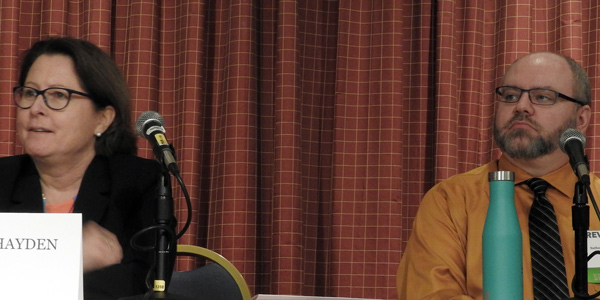By Michael Kuser
BURLINGTON, Vt. — Vermont isn’t just moving in the right direction on renewable energy; it’s helping to lead the country despite — or because of — its modest size, the state’s top regulator told attendees at a recent conference.
“Unlike New York and California, which want to lead on energy, Vermont is not a battleship, we’re a PT boat, so we can turn on a dime,” Vermont Public Utility Commission Chair Anthony Roisman said Oct. 2 at the Renewable Energy Vermont (REV) Conference.
Gov. Phil Scott appointed the 79-year-old Roisman as chair in June.
Vermont is one of the top two states nationwide in terms of clean energy employment as a share of the workforce. The 13,000 jobs created in the state’s sector since 2000 represent 6% of the state’s workforce, REV Executive Director Olivia Campbell Andersen said at the conference.
When Roisman served on the siting board for New Hampshire’s Seabrook nuclear plant 40 years ago, the people interested in renewable energy wouldn’t have filled one table, he noted. In contrast, the REV2017 Conference drew hundreds of people who not only promote renewable energy, but also work in the field.
Kerrick Johnson with Vermont Electric Power Co. asked Roisman how long he expects to serve in his current role, given his age.
“I have a six-year term and I can’t predict who the governor will be in six years, but I don’t see any finite limit to how long I will serve,” Roisman said. He noted that Berkshire Hathaway CEO Warren Buffett is 87 and U.S. Supreme Court Justice Ruth Bader Ginsburg is 84. “I feel as though I’m a little young for the position, but I’m hoping to make up for that with my enthusiasm and energy.”
Siege Mentality

During the conference, state officials described how they see Vermont, like the U.S., as standing at a critical crossroads in terms of both climate change and politics.
“When we have a federal government that abdicates its responsibility to protect its people and our environment, the attorney general’s office will be the first line of defense and the last line of defense,” said state Attorney General T.J. Donovan.
“Now we’re realizing that democracy is not just on election day, but all the time,” Lt. Gov. David Zuckerman said.
The growing season is going to be longer and both wetter and drier at the same time, he said.
“You say, ‘How is that possible?’ But we’ve seen it this year,” said Zuckerman, who owns a farm in Hinesburg. “This summer was one of the worst growing seasons, at the beginning of the season, that any farmer I know has seen, with incredible rains for a long time. And now my pond is almost empty because for the last month and a half it’s been very, very dry.”
Project Siting and Policy
Conference panelists also discussed how a 2016 state law that calls for greater local government involvement in the generation siting process has exacerbated the NIMBY syndrome.
The law (Act 174) represents “a big change from the status quo,” according to Alex “Sash” Lewis, a lawyer with Dunkiel Saunders Elliott Raubvogel & Hand. In the past, state officials had to give “due consideration” to local and regional planning standards when siting resources, but now they must give “substantial deference” to those requirements.
“The PUC is now going to be considering specific municipal plans,” he said.
The law establishes a new set of energy planning standards that municipalities and regions can adopt on a voluntary basis, earning them the right of substantial deference in the siting process. Regions and municipalities that do not wish to update their plans will continue to receive due consideration in the process.
Jon Copans of the Vermont Council on Rural Development considers that holistic approach to energy planning to be a good thing: “You can’t just look at the electric sector without considering many others.”
Catherine Dimitruk of the Northwest Regional Planning Commission pointed to a correlation between prime wind areas and nature conservation areas. She said her commission has a goal of developing 19 MW of new wind generation in the northwestern part of the state, to be achieved only through small-scale wind, and is relying on evolving technology to make it possible.
Kimberly Hayden, a lawyer with Paul Frank + Collins, said that in the past five years “our CO2 footprint has gone up 2.5% because, while we are retiring nuclear, we’re replacing it with natural gas-fired generation.” The New England Power Pool’s Integrating Markets and Public Policy process “looks very promising … but it’s very political.”
New York and Illinois are doing interesting work, but New York’s Value of Distributed Energy Resources Phase II process “will be going on until the end of time, which scares me,” said Nathan Phelps of advocacy group Vote Solar. “The market is really hurting in New York right now because of uncertainty, which scared off a lot of developers.”









